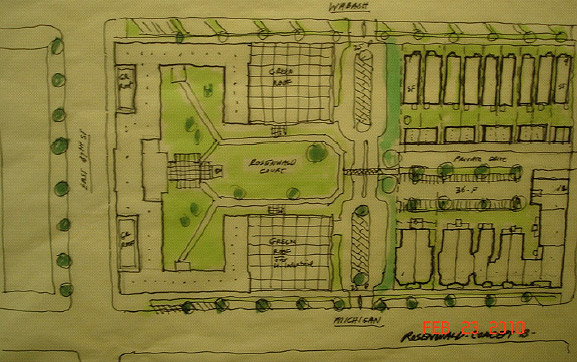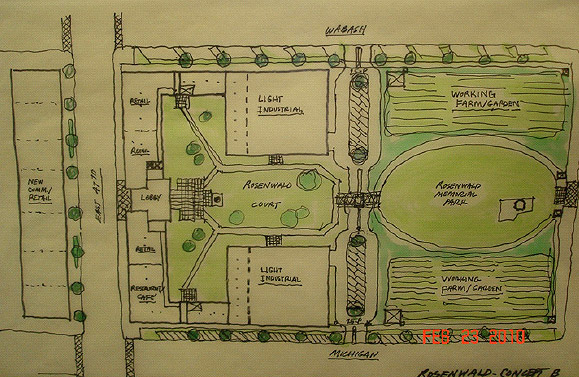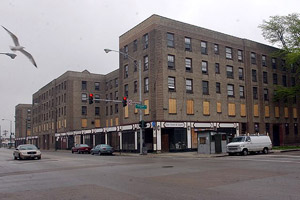Blair Kamin asks: "Is a bright future finally in store for one of Chicago's most noble experiments in affordable housing?"
When it comes to "affordable housing," people ususally think of government projects or public-private partnerships. But the Rosenwald Apartments were an entirely private, affordable-housing complex built by Julius Rosenwald, one of the many philanthropic projects he poured his Sears fortune into. It opened in 1930, with 421 apartments of three to five rooms—small, but well-appointed, with refridgerators and parquet floors. Even having been abandoned for many years, a wonderful Flickr gallery of what remains shows its elegance: a fireplace with gorgeous brickwork, built-in wood cabinetry. Apartments rented, in its first year, for an average of $62.27, or $857 in 2012 dollars. It was not inexpensive, but segregation drove up rents during the time:
And the Bosses of the Buildings take these old houses and convert them into "kitchenettes," and then rent them to us at rates so high that they make fabulous fortunes before the houses are too old for habitation…. They take, say, a seven-room apartment, which rents for $50 a month to whites, and cut it up into seven small apartments, of one room each…. The Bosses of the Buildings rent these kitchenettes to us at the rate of, say, $6 a week. Hence, the same apartment for which white people-who can get jobs anywhere and who receive higher wages than we-pay $50 a month is rented to us for $42 a week!
In its first year, immediately after the crash, the net income for the Rosenwald Apartments was $83,878, or a bit more than a million dollars in today's dollars. The Rosenwald Apartments—officially the Michigan Boulevard Garden Apartments—were meant to do for housing what Henry Ford did for the automobile, the director of the Rosenwald Fund told the Tribune:
Economists tell us that what we need today is another automobile industry to restore employment and prosperity. We have all been scanning the horizon for such an industry but we have not found it. For a time we thought it might be radio or television, but neither of these seem to meet the need. Of late it has occured to quite a number of people that what we are looking for may be right under our noses. The industry which may bring back prosperity could very well be the business of providing better living accomodations to families of moderate means. For a decade and more our prosperity was founded upon supplying automobiles to persons of limited income. Perhaps we would do as well by supplying the even greater need for places to live.
It was not meant to house the poor, but to provide decent housing for middle-class blacks in a city short of it. Quincy Jones grew up in the Rosenwald Apartments until the age of 10; his mother managed them, and his father was a carpenter there. In Q: The Autobiography of Quincy Jones, one of his childhood friends remembers his family, and the place they lived:
Sarah Jones was quite a woman before she got sick. She ran the Rosenwald Apartments over on 46th and Michigan Avenue. Back then the Rosenwald was the place for the colored in South Side Chicago. It was for the high-and-mighty of the colored race only. There must've been a hundred apartments in that place. Huge places with big bedrooms, stone staircases, a fountain in the plaza, fine wood floors. It would break your heart to see it now. It's like a prison. Metal gates and security guards, all kinds of folks shuffling in and out, it's a mess.
In 1957, Robert Taylor, who had helped Rosenwald develop the complex, attempted to turn it into a cooperative, but was unable to get financing for the project. At the time, the Grand Boulevard area was in decline, with the third-lowest median family income in the city at $2,527 in 1955, compared to a city median of $3,956 ($21,670 and $33,923 in 2012 dollars). The housing stock had declined as well; in 1955, the Tribune reported, "fifty-nine per cent of the dwelling units [in Grand Boulevard] lack a bath, lack water, or are dilapidated, and 25.2 per cent of them are crowded to the extent of 1.51 or more persons per room." Taylor died the next year. By 1967, it was also in decline: "eighty per cent of the building lacks rear exits, and the plumbing, wiring, heating, windows, plastering, and basement laundry area are in bad condition."
It hung on as housing through 2000, when the building's deteriorating gas system caused 118 units to be shut down; between that, lead paint, and rodents, the city moved out about 1,500 residents from the 425 occupied apartments. Since then it's been a boarded-up real-estate hot potato, though it made the National Register of Historic Places in 2005. But last year, as David Roeder reported, there was momentum towards restoring the Rosenwald Apartments:
David Roos, executive vice president of Landwhite, said he wants to convert the building into 332 units of senior or family housing, all reserved for low-income families. The project might cost $170 million, he said.
[snip]
Roos said he’s working on 14 sources of financing and hopes to close the sale by year-end. The City of Chicago is one potential source. The City Council has approved a first step toward a later issuance of federally tax-free housing revenue bonds totaling $58.6 million for Landwhite’s plans. City funds are not at risk, but tax-increment financing probably will figure in a final deal.
As of March the deal still hadn't yet gone through. A report by the Urban Land Institute details the challenges of fixing the Rosenwald: weather damage and ADA requirements would make rehabilitation extremely expensive—their estimate was over $144 million dollars for mixed-use retail/residential/office use. Light industrial use would cost less than half as much, but potential rental rates for light industrial use would be extremely low. Demolition would be cheaper, but it would add another empty lot to a blighted area, and a very large one at that.
The report suggests, as a compromise position, partial rehab combined with partial demolition and new construction, either a light industrial/garden mix or a mix of housing stock, retaining parts of the original building and landscaping:


A 2009 video shoot provides a look inside the Rosenwald, and how much of a problem the years of neglect have left the city:



